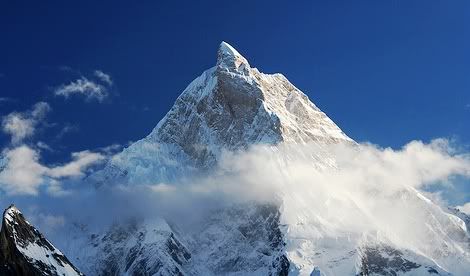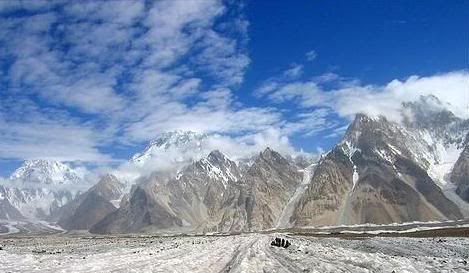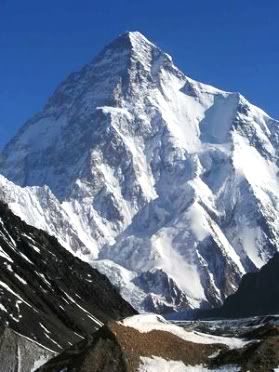 Most of our readers may know that K2, the world’s second highest peak, is also called Mount Godwin-Austen. It is named after Lieutenant-Colonel Henry Haversham Godwin-Austen (1834-1923) who was an Assistant on the Great Trigonometrical Survey of India. He was the first one to survey the area in modern times (1860s).
Most of our readers may know that K2, the world’s second highest peak, is also called Mount Godwin-Austen. It is named after Lieutenant-Colonel Henry Haversham Godwin-Austen (1834-1923) who was an Assistant on the Great Trigonometrical Survey of India. He was the first one to survey the area in modern times (1860s).
He wrote a paper which was read at the Royal Geographical Society meeting on January 11, 1864 and published in the society journal in the same year.
In this publication Godwin-Austen recalls a scene of a flash flood and land-slide that he witnessed while camped out between Mustakh Range and Skardu as follows:
Whilst lying in my tent, after finishing my work, I heard an unusual rumbling sound, and on going out I found all the men were wondering what it could be. After a few more seconds of suspense, some Balti coolies, who were cutting brushwood higher up the ravine, shouted that the stream was coming down, and in few seconds more we saw a black mass coming out of a lateral ravine from the right, and moving rapidly over the broad shape of boulders which formed the bed of the valley. Before the black stream reached us it divided into two, and we then saw that it consisted of mass of stones and thick mud, about 30 yards in breadth, and about 15 feet deep. The servants by the side of the little rill near the tents had just time to escape before it came down upon their fires. It was the most wonderful sight: a great moving, mass of stones and rock, some of great size, measuring 10 feet by 6, all travelling together like peas shot out of a bag, rumbling and tumbling one over the other, and causing the ground to shake. No one, who has not seen a flood of this kind, can form any idea of the mighty power of transport which the accumulated masses of water and melting snow acquire at these times, and I was almost bewildered by the spectacle (Godwin-Austen (1864), pp.27-28.)
On The Beauty of Skardu Valley:
In the same paper he also describes the beauty of Skardu valley which he witnessed one early morning.
Next morning, as the light in the east grew stronger, the view was never to be forgotten. From the south-east to north-west, the whole range of snowy mountains was visible, with only a few streaky purple clouds lying beneath them, which, without obscuring any of their sharp forms, added to their immense heights. K1 (Masher-brum) and K2, the second highest in the world, overtopped them all, and were conspicuous from their fine shapes (Godwin-Austen (1864)), p.27.)
Simplicity of Local People:
Godwin-Austen also describes the simplicity and innocence of local villagers of Skardu valley and how their material needs were very limited:
They dress entirely on puttoo, or woollen cloth, which they make themselves: cotton is never used, not even for turbans. Their knowledge of the world is almost limited to their own wild ravines, and though many have crossed the Mustakh (mountain range in Northern Pakistan), I met with very few, in the other direction, had been beyond Skardo (Skardu). During the winter months the men are engaged in hunting the Ibex, when these are driven off the higher ground by the snow and come down to streams. The animals are run down by dogs, which they take care of and prize highly. (p.45.)
Following photo is a face-on view of Masherbrum (K1) peak

On Weather-Hardiness of Locals:
Godwin Austin also recalls how local people were able to bear the strong weather in these words:
The wond blew all night, getting stronger towards morning; and I pitied the poor coolies with only the rough, sharp stones to lie on, and separate them from the ice. The Balti, who carry only one rug, huddled together two or three under the same covering. Mahomed told me next morning that he heard them saying, “Would that the Sahib felt it as cold as this! He would soon go back.” (p.39.)
Reference:
1. Rare Maps of Pakistan by F.S. Aijazuddin
Photo Credits: Clicking on the photos above will take you to their source websites.
1. Title Photo is courtesy of Tree_Elf_ at Flickr.com.
2. K2’s photo is courtesy of howsthat at Flickr.com
3. K1’s photo is courtesy of Aitor Las Hayas at Flickr.com
4. Godwin-Austen’s protrait is from Wikipedia.




















































I met Godwin Austen’s nephew in London and he said that Austen married a local girl and had a daughter who had contacted him.
Do you know anything about this marraige in Pakistan?
Great information.Hope to see more from you, as this was really informative.Thanks, wish you all luck.
Mansoor, i have not found the paper online yet. I found the Godwin-Austen excerpts from a book that I have. It is called ‘Rare Maps of Pakistan’ by F.S. Aijazuddin
Good post. Is the Austin’s paper available for reading online?? Kindly give the link for that.
Sir for you and all muslims ..eid doodle
http://www.propakistani.com/2008/09/26/eid-ul-fitr -google-doodle-for-the-world-muslim-community/#com ment-4771